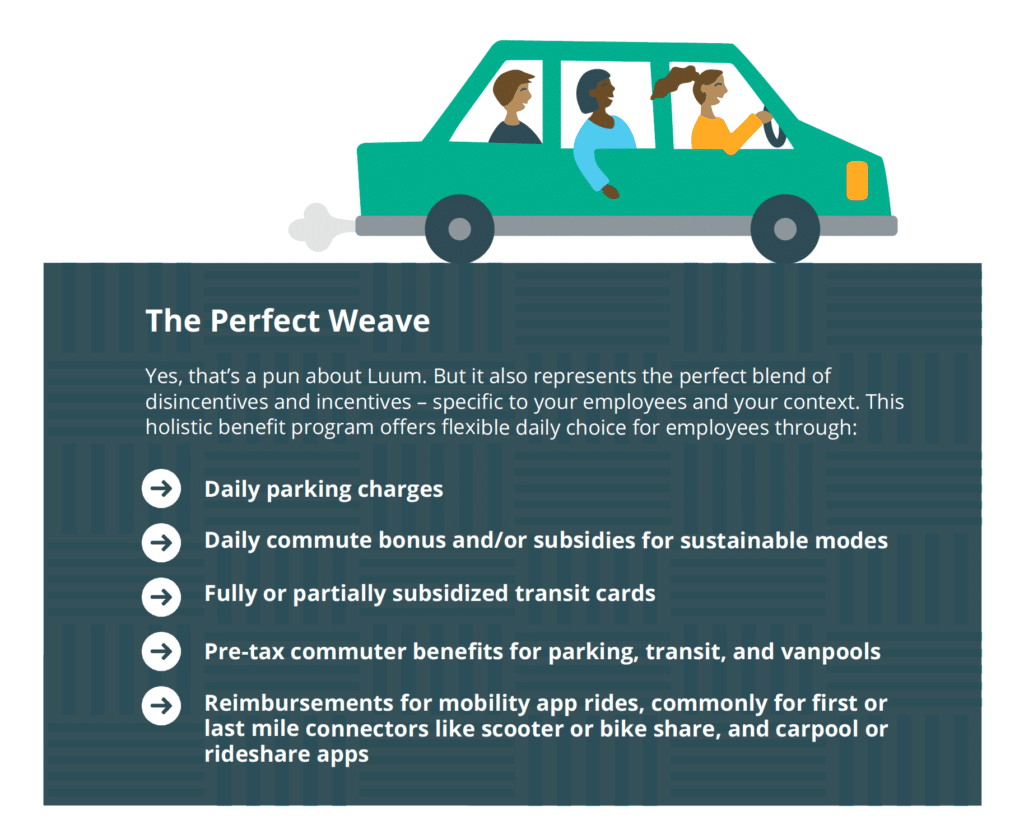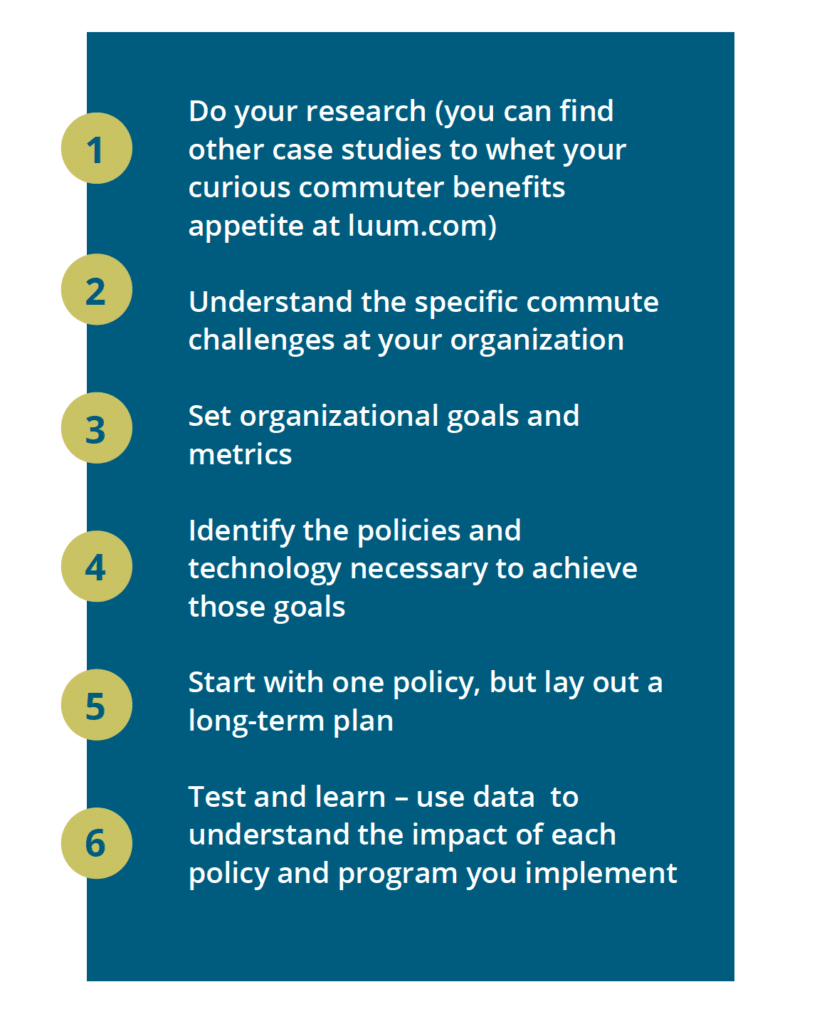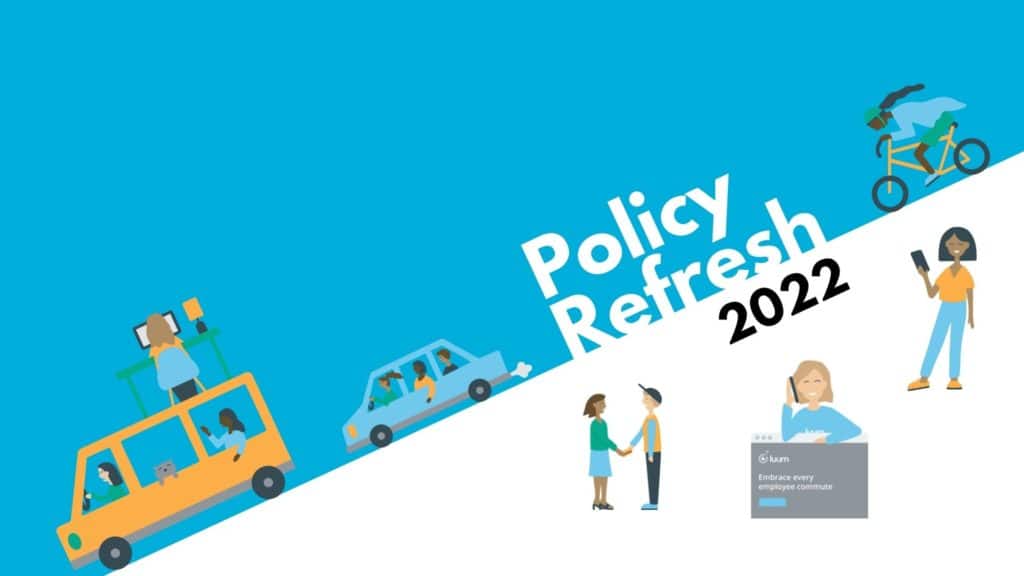Return to Better: Commuter Benefit Policies For 2022 and Beyond
Daily flexibility and choice will keep your commuters safe, happy, and productive.

Whether your workforce has been commuting throughout the pandemic or returning to office in 2022, it’s essential to build daily choice and flexibility into your commute program. Giving your team the tools they need to make those trips between home and work starts with policy enhancement. From parking improvements to mobility options, here’s your guide to finding the very best commuter policies for your workplace
The most common question we get asked at Luum by employers is: Where do I start?
And coming in a close second: If I can only implement one policy change, which is the most effective in changing commuter behaviors?
While there’s no “one size fits all” in commuter benefits, many of our customers have shown that a transit subsidy is the most impactful policy in kickstarting a commuter benefits program. Though some employers may be unsure about promoting transit use during a pandemic, there has been no evidence demonstrating Covid-19 spread on public transit. Data also shows that those who will return to office, even if just a few days per week, want to reengage with their pre-COVID commute of choice—signaling a return to transit for many who previously utilized it.
Employers are also shifting focus to another pivotal policy change that has been proven to significantly reduce overall parking demand while maximizing daily asset utilization: daily parking charges. Our data shows that daily parking charges can disrupt entrenched habits—like parking every day—by encouraging daily choice. Research proves that ‘sticks’ or ‘disincentives’ are the most impactful at changing behaviors.
What’s more—given that all signs point to telework outlasting the pandemic—daily parking charges are what employees and staff will need. They don’t want to pay for a monthly permit when they may only commute to the office three days a week. Employees only want to pay for the days they actually drive to work and park.
Daily parking charges benefit parking managers, too, because they don’t want to waste a parking stall on an employee with a monthly parking permit who only uses it 60% of the time. By opening up your owned or leased parking to daily charges, everyone wins.
With a technology partner, the switch from monthly parking permits to daily parking charges is simple and painless for administrators and employees alike. If you’re interested in learning more about this shift, check out this case study from Oregon Health and Science University that speaks to the success of our customers that have made this shift to daily parking.
Now, let’s say your company doesn’t currently charge anything for employee parking. And the thought of charging for parking is scary, startling, or had you muttering ‘not a chance’ under your breath…please keep reading. You are not alone. This philosophy goes against the norm in North America, which subsidizes driving and parking. It is always hardest to be the first in a region or company to break from a norm.

Most commuter benefits programs do not begin with daily parking charges, especially without any subsidies in place for alternative modes. A holistic program is one that balances incentives and disincentives (monetary and otherwise) to provide daily flexibility and ultimately shift the commute culture at your organization away from driving alone.
Commuter benefits programs slowly work up to charging for parking—often planning it for years, phasing into it with measured policy changes. We live in a world where the true cost of parking is always hidden. Because of this, it is only natural that we feel entitled to free or subsidized parking. Shifting attitudes is just as difficult as changing behaviors, so let’s take it back and look at where most employers start.
Common Commuter Benefits Policies
The employers who approach us typically don’t have systems or software in place to run their desired commuter benefits program effectively. Because of this, we commonly see some combination of the following policies at play:
The Goose Egg

This policy is easy to describe – it’s nothing. The employer sees it as the employees’ responsibility to get themselves to work and see no need for a commuter benefits program. The pandemic has proven this line of thinking is outmoded. When COVID hit, employers realized they must support their employees in getting to work safely—and match the flexibility of a future hybrid workplace with flexible commute and parking policies. A new normal is developing right now, especially as employers compete for talent with newfound flexibility in the workplace. Therefore, delivering equally flexible commute benefits is now a key part of the employee experience.
The Blind Side

This policy is pretty simple, as a commute ‘benefit,’ employers offer free parking. This benefit is short-sighted. Employees who drive to work report higher levels of stress and lower job satisfaction compared to train commuters, and there are long-term health benefits of sustainable commuting. Plus, if every employee drives alone to work, just think about how much added real estate is needed to store their cars for 8-10 hours a day. Given the cost of one parking space ($200-400 per month depending on the city), this is no small cost for the employer and sets them up for unnecessary expenses and challenges in the future. The best part? Even nominal parking charges will make a huge impact in demand – just a few dollars make employees think twice about their options.
Finally, I’ve heard many companies cite employee retention as the main reason against charging for parking. While an understandable concern, there is no research to back this claim. In fact, at a recent Association of Commuter Transportation (ACT) conference the Commute Program Manager for a major tech company told the audience how they started successfully charging for parking at their office in Texas – Texas of all places! Charging for parking is not the norm in this state, and while some employees grumbled at the change the first week or two, it didn’t last long. Fast forward a few months: no employees have left the company due to the parking charges and parking demand was cut in half.
The Pensioner

Just like pensions are becoming ‘old school,’ so are some commuter benefit programs that rely only on existing programs for their commuter benefits programs. The Pensioner tacks on pre-tax benefits for parking and transit through their FSA/HSA provider and relies on a regional entity to nudge carpooling through an open platform or matching service. Here’s the problem: when pre-tax benefits are buried within the HR system, they have historically low participation. Beyond that, ‘nudges’ have been proven ineffective at changing commute behaviors. Traditional pension programs are mandatory opt-in, while commuter benefits are opt-in only, and often not promoted and bundled as part of a holistic commuter program.
Looking ahead to 2021, integrated and flexible pre-tax commuter benefits are on the rise. They are a budget-conscious choice for employers because they are essentially a no-cost benefit. Employees set aside pre-tax dollars for either parking or transit expenses (including vanpool), and the employer saves on payroll taxes. When pre-tax benefits are integrated into a holistic commute management platform, they can be managed alongside parking permits and charges, daily reservations, as well as any subsidies or reimbursements for sustainable commutes.
The Beer Fund

While this policy may sound great on the surface, it falls short in providing business value. The Beer Fund is simply giving employees who agree not to drive around $100 per month extra on their paycheck. Offering non-drivers a benefit similar to the benefit they offer drivers (free or subsidized parking) is equitable, but it falls short because it fails to incorporate daily choice.
Instead, employers should reward specific sustainable modes of their choosing with a daily bonus that equates to the same $100 per month. Similar to daily parking, this makes the commute a daily choice, allowing employees to drive some days and ride transit on others.
The Catch 22

In the Catch-22, employees have to pick one or the other: a subsidized transit pass or a subsidized parking space. Without even mentioning the inequity—transit passes are about half the cost of parking spaces in most cities—this policy has one major problem similar to the Beer Fund. It locks employees into one mode choice and doesn’t provide flexibility. In the 2022 new normal, the ‘pick one’ commute policies will not work because employees may want to drive some days, but use transit, telework, or rideshare on other days.
What’s more, since the default in North America is driving alone to work (76% of Americans), many employees will choose the subsidized parking space, and therefore drive most days due to the sunk cost fallacy. This policy is in direct opposition to a belief held close at Luum – it’s not about never driving, it’s about driving less. If you want policies that provide flexibility and options for employees, but ultimately reduce the frequency of drive alone trips, there can be no ‘either or,’ but rather ‘yes and.’
The California Rick-Roll

This policy gets its name as a stereotype of Silicon Valley, but you can find it across the country. The California Rick-Roll consists of free parking, corporate shuttles, and valet parking for garage overflow. Free parking and valet parking are unsustainable, short-term fixes. Plus, along with corporate shuttles, they are crazy expensive. This doesn’t solve for or recognize the true problem: free parking.
Now employers are getting smarter and using technology to understand their commute program and parking costs, therefore offering flexibility and implementing daily parking charges to address the source of the problem, not the result.
Where To Go From Here
If you are starting at any one of these policies, you are not alone. Implementing a workforce mobility program can enhance the lives of your employees. You have a lot of opportunities for positive change. To what, you ask? What is the ideal policy combination we should implement in 2022?

The single commute platform through which you administer these policies will provide data insights that clearly communicate the ROI on your commute program. Employers who implement these policies boast massive reductions in parking demand, a positive commute culture, and employees who feel that their employer truly cares for their entire workplace experience – which begins and ends with a commute each day.
New Year, New Mode
Resolutions let us reflect on ourselves and our environments and make intentional changes. But they require a great deal of effort to implement successfully. To get to the Perfect Weave, at any organization, there must be cross-departmental collaboration, change management and, at times, discomfort. Our advice is simple:

In Summary
We can’t continue business as usual and hope for the best as we return to the workplace in 2022.
Organizations need bold policy changes to manage parking demand and provide daily flexibility for employees. Get rid of policies that force employees to pick one mode and stick with it. Daily parking charges and reservations are a great place to start—right now.
It takes time to change entrenched commute policies and car culture. But 2022 will be a time of change for all, just like 2020. Now is the moment to implement forward-thinking policies and change previous norms. A flexible commute and parking program will prepare your organization for whatever the future brings and provide resilience and prosperity for the long term.
Step by step, you can reach your organization’s commute goals and ensure your commuter benefits program perfectly weaves together everything your employees need. Kick off your new flexible, resilient commuter benefits program in 2022!
Want to learn more about moving your commute program from Catch-22 to a Catch All? We can help get you there.
More In the Luumlight
HR Dive: Enterprise employers navigate the hybrid commute
Our annual virtual conference, Luuminary22, was held on July 20th. We gathered a wonderful group of leaders to discuss the hottest topics of 2022: including…
Your hybrid workforce doesn’t need commuter benefits. They need mobility benefits.
Life is not the same as it once was. The workforce is continually changing, and so are employees’ needs, causing a rethink in the ways…
Return to Better: Commuter Benefit Policies For 2022 and Beyond
Daily flexibility and choice will keep your commuters safe, happy, and productive. Whether your workforce has been commuting throughout the pandemic or returning to office…



